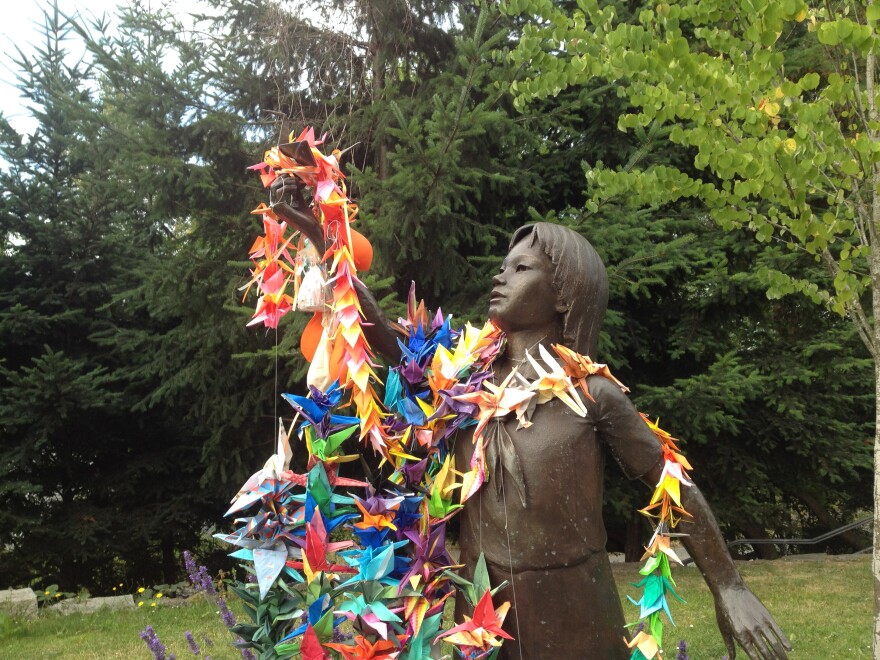Fumiko Uyeda Groves was 11 years old when the atomic bomb “Little Boy” was dropped on Hiroshima on Aug. 6, 1945. She was living in Seattle at the time, having returned four months earlier after being incarcerated at Idaho’s Minidoka Relocation Center for three years.
“I found out about it over the radio, just as we had found out about Pearl Harbor over the radio,” said Groves, who is now the president of the Seattle Hiroshima Club. “My parents were very concerned about if my relatives were OK or not.”
'We Felt Very Sad, But Very Helpless'

The 10,000-pound bomb and its aftereffects killed an estimated 140,000 people, including Grove’s aunt, uncle and cousins. Three days later, another atomic bomb called “Fat Man” was dropped on Nagasaki. Some quarter-million people died from the two nuclear weapons. Groves’ family didn't learn about their relatives’ deaths for more than five months.
“We felt very sad, but very helpless,” she said.
Growing up in Seattle after WWII, Groves felt that it was shameful to be Japanese.
“As we were going through school, we kept being reminded that we were part of a melting pot,” she said. “So consequently, many of us lost the culture and the traditions because we were very anxious to become true Americans.”
But she stayed connected with her culture through the Seattle Hiroshima Club, of which her dad was president for 24 years. Three years ago, Groves herself became the club's president, and now chairs an annual atomic bomb victims’ memorial service at Seattle Buddhist Church. The 45th annual service was held on Sunday, Aug. 3, and honored 28 victims from the Seattle area.
'Shikata Ga Nai' ('It Cannot Be Helped')

Groves described the ceremony as being "a celebration and respectful" rather than a strictly solemn affair. She referenced the Japanese saying "Shikataganai," which means "it cannot be helped."
“What I learned from my parents is it doesn’t do any good to be sad and remorseful. You have to carry on and do whatever you think that the people who passed away would have wanted you to do,” she said.

The service included Sutra chanting, incense offering and the choir’s rendition of ShunjiIwai’s “Flowers Will Bloom,” which was written for the Fukushima Daiichi nuclear disaster victims in 2011.
In Rev. Jim Warrick’s sermon, known as the Dharma message, he referenced the story of atomic bomb victim SadakoSasaki. Sadako, who was diagnosed with leukemia after the bombing, tried folding a thousand origami cranes so her wish of getting better would be granted. She died at age 12 in 1955.
'Let There Be No More Wars'
From the annual service and being part of the club, Groves said she has become closer to the people in Hiroshima. It also made her ask more questions about the atomic bombings that happened when Groves was a child.
“The biggest thing that has come out of my questioning is what everybody in Hiroshima says, which is: Let there be no more wars, and let there be no more nuclear activity,” she said.
In 2010, Seattle Hiroshima Club interviewed eight survivors of the Hiroshima atomic bombing. The rest of the interviews can be found on the club's website.
Planned Events
The public is invited to honor the atomic bomb victims Wednesday night at Seattle's annual lantern-floating ceremony, "From Hiroshima to Hope," at Green Lake.
6 p.m. — Gathering
- Lantern calligraphy, meditation, picnicking, traditional music, photography exhibit
7 p.m. — Family Program
- Emcee: Jacqueline Moscou, artistic director, Langston Hughes Cultural Center
- Keynote speaker: Kathleen Flenniken, former poet laureate of Washington state
- Blessing: Rev. Berhanu Seyoum, pastor, Mekane Yesus Evangelical Lutheran
- Music: Seattle Kokon Taiko, Kimo Muraki
- Poem: Mariah McHenry
8:30 p.m. — Toro Nagashi
- Lantern-floating ceremony led by Choeizan Enkyoji Buddhist Temple and Nipponzan Myohoji Dojo
- Music: Marcia Takamura on koto, James Jennings on shakuhachi
More information can be found on fromhiroshimatohope.org.




